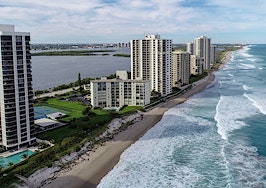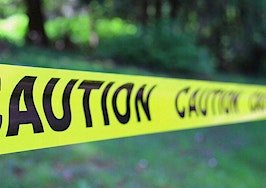When someone calls 911 in an emergency, knowing the exact location of the caller can mean the difference between life and death. But many of those calls are made with cell phones, which often don’t automatically provide the caller’s precise address. Lee Goldstein, co-founder and CEO of Real Safe Agent, has come up with a tool that does just that.
Six years ago, Goldstein launched Real Safe Agent, a system and accompanying mobile app that allow users to rank their level of comfort with client prospects, make more informed decisions about whether it’d be a good idea to bring another person along to an appointment, connect with agents in the area who could accompany them, and issue drop-in alerts to nearby agents if they become uncomfortable. Since then, Real Safe Agent has been deployed to more than 120,000 agents, according to a press release.

Lee Goldstein
This week, Goldstein launched Real Safe 911, an app and system from Real Safe Brands, a company Goldstein founded in February. Through the app, a user can call 911 and the 911 operator will automatically receive the user’s address regardless of whether the call center is using the app. The app will also notify the user’s emergency contacts and allow them to track the user’s exact location.
The app is “fully integrated” into the nation’s 911 system, Goldstein told Inman via email.
“[T]he address that is sent is the address of where you are at that moment,” he said. “The way it works is this: You can enter up to four preset addresses (i.e. home, work, gym, friend’s house). If you need emergency services you can hit the button where you’re currently located and then hit call ‘Call Emergency Services.’

Screenshot of the caller’s main screen, courtesy of Real Safe Brands
“If you are not in one of those four places then you can hit ‘Use My GPS’ [and] the app will then geocode your address and give you the opportunity to edit the address (add an apartment number, for example) and then you can hit ‘Call Emergency Services.’ If for any reason your address cannot be geocoded then a human will use your GPS coordinates and contact the [911 call center] for you with your exact location. So regardless of your actions, once you hit Call Emergency Services they will know where you are.”

Screenshot of address confirmation for caller, courtesy of Real Safe Brands
First responders who have also downloaded the app will also be able to see the caller’s exact GPS location and key medical information the caller chooses to share. First responders will also be able to initiate a four-way video call with the caller, the caller’s emergency contacts and other first responders.

Screenshot of first responder overview, courtesy of Real Safe Brands
“Real Safe 911 is a monumental advancement,” said Dr. Gregory Charlop, a licensed physician in private practice and a former Inman contributor, in a statement. “The location sending is giant in and of itself, but when you add access to key medical information in an emergency, emergency contact notification, and the video conferencing features; the implications for emergency medicine are endless.”
A real estate agent could use the app if an emergency occurs during a showing, for instance, according to Goldstein. An agent could then enter the address of the listing and call for emergency services. “[E]ven if you hang up they will know where you are and can send police,” he said.
Goldstein provided several other examples of instances where the app could prove useful:
- A 911 operator or paramedic can see an injured child and talk the parent through how to help while the ambulance is on its way.
- A paramedic could conduct an emergency telemedicine call with an emergency room doctor and an emergency contact.
- A paramedic or doctor could have a full medication list and recent acute issues before seeing the patient.
- Fire and rescue personnel can see what the caller sees before arriving so resources can be deployed faster or not over-deployed.
- Police can see what a caller sees. “This is invaluable in the most common police calls: ‘suspicious person.'” Goldstein said. “Now an officer can see before they get there if it’s a prowler or a kid selling magazines door to door.”
- A police officer, medical worker or rescue personnel dealing with a disturbed or agitated individual could initiate a video call with a mental health worker to assist in the situation.
- A high-profile, mass casualty event.

Screenshot of video call feature, courtesy of Real Safe Brands
The app, available through the Apple App Store and Google Play Store, requires a subscription of $9.99 per month for users, though anyone who subscribes in the next 90 days will secure a $4.99 per month subscription, Goldstein said. The company is currently only offering individual subscriptions.
The app is free for first responders, including all fire, emergency medical, police, emergency room and municipal services. Such services can register for free at realsafe911.com and will then receive a code that allows them to install the app at no charge.
“We know that what we are doing is life saving for those who need help, and transformative for those who provide that help,” Goldstein said in a statement. “We wanted to make this technology free to the first responders and public services that we all rely on in an emergency.”
According to Goldstein, the main audience for the app are people over 50 and those with critical health issues that first responders need to know and who have a higher likelihood of needing emergency services, such as people with diabetes, epilepsy or severe allergies. Other markets for the app may include people who live in apartments or rural areas or those who travel a lot or deal with elevated risk in multiple locations, Goldstein said.
“Our data indicates that people will pay for the services because response time in an emergency, ensuring that emergency contacts can find them in an emergency and the idea of emergency telemedicine that could include an emergency contact are features in which they find value,” he said.
“We believe that the service will be successful because medical alert devices and bracelets deliver less than Real Safe 911 delivers, and Real Safe 911 is less than one third the cost of most of the medical alert devices and bracelets.”






